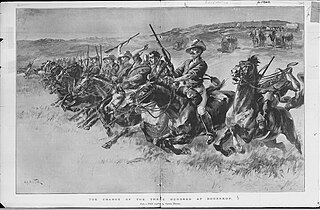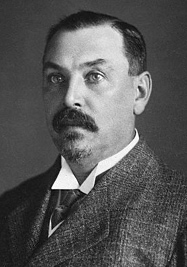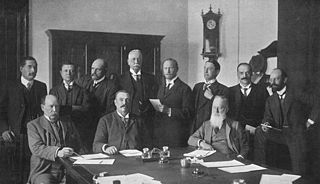
The Union of South Africa was the historical predecessor to the present-day Republic of South Africa. It came into existence on 31 May 1910 with the unification of the Cape, Natal, Transvaal, and Orange River colonies. It included the territories that were formerly part of the South African Republic and the Orange Free State.

The Jameson Raid was a botched raid against the South African Republic carried out by British colonial administrator Leander Starr Jameson, under the employment of Cecil Rhodes. It involved 500 British South Africa Company police and was launched from Rhodesia over the New Year weekend of 1895–96. Paul Kruger, for whom Rhodes had great personal hatred, was president of the South African Republic at the time. The raid was intended to trigger an uprising by the primarily British expatriate workers in the Transvaal but it failed.
The Second Anglo-Boer War had no sooner commenced with the ultimatum of the Transvaal Republic on 9 October 1899, than Mr Schreiner found himself called upon to deal with the conduct of Cape rebels. The rebels joined the invading forces of President Steyn, whose false assurances Mr Schreiner had offered to an indignant House of Assembly only a few weeks before. The war on the part of the Republics was evidently not to be merely one of self-defence. It was one of aggression and aggrandisement. Mr Schreiner ultimately addressed, as prime minister, a sharp remonstrance to President Steyn for allowing his burghers to invade the colony. He also co-operated with Sir Alfred Milner, and used his influence to restrain the Bond.

Sir Leander Starr Jameson, 1st Baronet,, also known as Starr Jameson, was a British colonial politician, who was best known for his involvement in the ill-fated Jameson Raid.

John Xavier Merriman was a South African politician who served as the eleventh Prime Minister of the Cape Colony from 1908 to 1910. He was the last prime minister of the Cape Colony before the formation of the Union of South Africa in 1910.
The Senate was the upper house of the Parliament of South Africa between 1910 and its abolition from 1 January 1981, and between 1994 and 1997.
The South African Party was a political party that existed in the Union of South Africa from 1911 to 1934.

General elections were held in South Africa on 15 September 1910 to elect the 121 members of the House of Assembly. They were the first general election after the Union of South Africa was created on 31 May 1910.

The leader of the opposition in South Africa is the leader of the largest political party in the National Assembly that is not in government. The House of Assembly was the most important House from 1910 to 1994 and the National Assembly from 1994. The leader of the opposition acts as the public face of the opposition, leading the Official Opposition Shadow Cabinet and the challenge to the government on the floor of Parliament. They thus act as a chief critic of the government and ultimately attempt to portray the opposition as a feasible alternate government.

The South Africa Act 1909 was an act of the Parliament of the United Kingdom that created the Union of South Africa out of the former Cape, Natal, Orange River, and Transvaal colonies. The Act also allowed for potential admission of Rhodesia into the Union, a proposal rejected by Rhodesian colonists in a 1922 referendum. The draft proposal was supported by the four colonial parliaments, but was opposed by Cape Colony premier W. P. Schreiner, who raised concerns that it would strip rights from non-white South Africans.

During the Napoleonic Wars, the Cape Colony was annexed by the British and officially became their colony in 1815. Britain encouraged settlers to the Cape, and in particular, sponsored the 1820 Settlers to farm in the disputed area between the colony and the Xhosa in what is now the Eastern Cape. The changing image of the Cape from Dutch to British excluded the Dutch farmers in the area, the Boers who in the 1820s started their Great Trek to the northern areas of modern South Africa. This period also marked the rise in power of the Zulu under their king Shaka Zulu. Subsequently, several conflicts arose between the British, Boers and Zulus, which led to the Zulu defeat and the ultimate Boer defeat in the Second Anglo-Boer War. However, the Treaty of Vereeniging established the framework of South African limited independence as the Union of South Africa.

The South African Wars, including but also known as the Confederation Wars, were a series of wars that occurred in the southern portion of the African continent between 1879 and 1915. Ethnic, political, and social tensions between European colonial powers and indigenous Africans led to increasing hostilities, culminating in a series of wars and revolts, which had lasting repercussions on the entire region. A key factor behind the growth of these tensions was the pursuit of commerce and resources, both by countries and individuals, especially following the discoveries of gold in the region in 1862 and diamonds in 1867.
Although the Democratic Alliance of South Africa in its present form is fairly new, its roots can be traced far back in South African political history, through a complex sequence of splits and mergers.

Sir James Molteno, was an influential barrister and parliamentarian of South Africa.
The Progressive Party of the Cape Colony was a political party in the Cape Parliament that was primarily composed of and supported by white immigrants to the Cape. It supported pro-imperialist policies, and was in power from 1900 until 1908.

Sir William Thomas Smartt was an Irish-born South African politician, and founder and leader of the Unionist Party.

The Louis Botha government appointed the members of the government in South Africa led by Prime Minister Louis Botha between 31 May 1910 and 3 September 1919.

The National Convention, also known as the Convention on the Closer Union of South Africa or the Closer Union Convention, was a constitutional convention held between 1908 and 1909 in Durban, Cape Town and Bloemfontein. The convention led to the adoption of the South Africa Act by the British Parliament and thus to the creation of the Union of South Africa. The four colonies of the area that would become South Africa - the Cape Colony, Natal Colony, the Orange River Colony and the Transvaal Colony - were represented at the convention, along with a delegation from Rhodesia. There were 33 delegates in total, with the Cape being represented by 12, the Transvaal eight, the Orange River five, Natal five, and Rhodesia three. The convention was held behind closed doors, in the fear that a public affair would lead delegates to refuse compromising on contentious areas of disagreement. All the delegates were white men, a third of them were farmers, ten were lawyers, and some were academics. Two-thirds had fought on either side of the Second Boer War.
Fort Beaufort was a constituency in the Cape Province of South Africa, which existed from 1910 to 1966. Named after the town of Fort Beaufort, the seat covered a rural area in the centre of the Eastern Cape. Throughout its existence it elected one member to the House of Assembly and one to the Cape Provincial Council.

Cape Town Harbour was a constituency in the Cape Province of South Africa, which existed from 1910 to 1929. It covered an area along the coast of Cape Town, including parts of the CBD as well as the Sea Point area. Throughout its existence it elected one member to the House of Assembly and one to the Cape Provincial Council.














